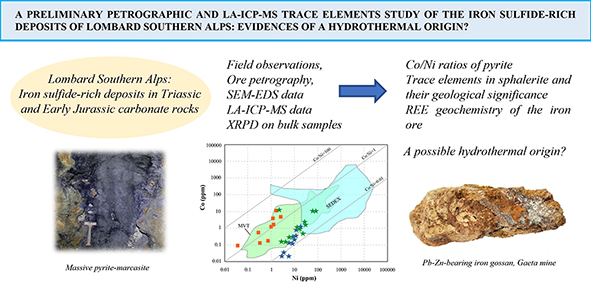A preliminary petrographic and LA-ICP-MS trace elements study of the iron sulfide-rich deposits of Lombard Southern Alps: evidences of a hydrothermal origin?
DOI:
https://doi.org/10.13133/2239-1002/17758Abstract
Limonite-rich iron deposits hosted in Middle Triassic to Early Jurassic limestones can be found in the Como Lake-Valsassina and Val Seriana areas (Southern Alps, Lombardy). These deposits were never studied in detail, other than a recent short publication about the petrography of the Piani d’Erna limonite deposit (Lecco). The aim of this paper is a preliminary study about these little-known iron deposits, that were important for iron production mainly in antiquity (from the late Iron Age up to medieval times). The limonite-rich iron deposits of the Lombard southern Alps were studied by field and petrographic investigations, SEM-EDS, LA-ICP-MS and XRPD analyses. The gossan-type iron deposits in the Como Lake-Valsassina and Val Seriana-West Iseo Lake areas show very different features and probably a different genesis. The limonite-rich deposits of the Como Lake-Valsassina area are linked to the weathering of a Fe-Pb-Zn-Ba epigenetic low temperature mineralization. Their genesis seems to be linked to the migration of Fe-Pb-Zn-Ba-rich reducing basinal fluids that seeped along strongly fractured portions of the Esino Fm., with a possible genetic-link with the Resinelli Pb-Zn-Fe-Ba-F Alpine-type deposits. While the Val Seriana-West Iseo Lake area deposits are Pb-Zn-poor and possibly originate from weathering of a hydrothermal pyrite-rich mineralization.

Downloads
Additional Files
Published
Issue
Section
License
Copyright (c) 2022 Periodico di Mineralogia

This work is licensed under a Creative Commons Attribution 4.0 International License.

